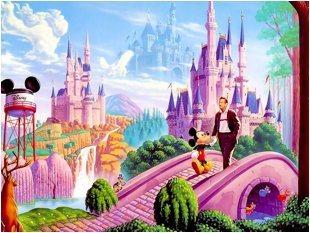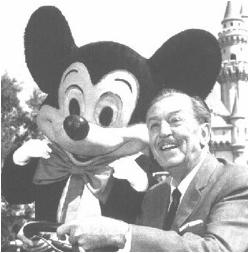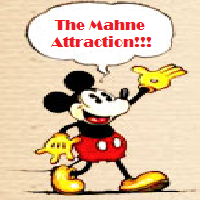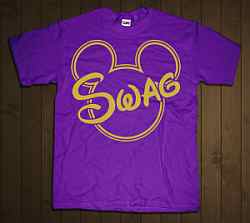FROM: The Mahne Attraction Published Regularly
Walt Disney: What A Life!
Keith talks about the life of the visionary that was Walter Elias Disney. The New York Times had an incredible recap of his life and it's content is incorporated here.

Recently, I attempted to find out what it was like the day Walt died; not just for his company but for the entire world. I came across this New York Times article from December 16, 1966. I think it gives a great look into Walt’s life and thought I should share it with all of you. It also shows us what projects Walt was working on rite before his passing. What an amazing life this man had and this article clearly puts this into prospective. It starts off a little dreary as it states Walt’s passing but yet I came away enlightened and proud of the life Walt lead and how it continues to touch the hearts of people today. I hope you come away with the same enlightened feeling I had, and who knows, you might even learn a thing or two about one of the world’s most amazing journeys through life!

******************************************************************************
December 16, 1966
OBITUARY
Walt Disney, 65, Dies on Coast; Founded an Empire on a Mouse
Los Angeles, Dec. 15--Walt Disney, who built his whimsical cartoon world of Mickey Mouse, Donald Duck and Snow White and the Seven Dwarfs into a $100-million-a-year entertainment empire, died in St. Joseph's Hospital here this morning. He was 65 years old.
His death, at 9:35 A.M., was attributed to acute circulatory collapse. He had undergone surgery at the hospital a month ago for the removal of a lung tumor that was discovered after he entered the hospital for treatment of an old neck injury received in a polo match. On Nov. 30 he re-entered the hospital for a "post-operative checkup."
Just before his last illness, Mr. Disney was supervising the construction of a new Disneyland in Florida, a ski resort in Sequoia National Forest and the renovation of the 10-year-old Disneyland at Anaheim. His motion-picture studio was turning out six new productions and several television shows and he was spearheading the development of the vast University of the Arts, called Cal Art, now under construction here.
Although Mr. Disney held no formal title at Walt Disney Productions, he was in direct charge of the company and was deeply involved in all its operations. Indeed, with the recent decision of Jack L. Warner to sell his interest in the Warner Brothers studio, Mr. Disney was the last of Hollywood's veteran moviemakers who remained in personal control of a major studio.
Roy Disney, Walt Disney's 74-year-old brother, who is president and chairman of Walt Disney Productions and who directs its financial operations, said:
"We will continue to operate Walt's company in the way that he had established and guided it. All of the plans for the future that Walt had begun will continue to move ahead."
Besides his brother, Mr. Disney is survived by his widow, Lillian, two daughters, Mrs. Ron Miller and Mrs. Robert Brown.
A private funeral service will be held at a time to be announced.
Weaver of Fantasies
From his fertile imagination and industrious factory of drawing boards, Walt Elias Disney fashioned the most popular movie stars ever to come from Hollywood and created one of the most fantastic entertainment empires in history.
In return for the happiness he supplied, the world lavished wealth and tributes upon him. He was probably the only man in Hollywood to have been praised by both the American Legion and the Soviet Union.
Where any other Hollywood producer would have been happy to get one Academy Award--the highest honor in American movies--Mr. Disney smashed all records by accumulating 29 Oscars.
"We're selling corn," Mr. Disney once told a reporter, "and I like corn."
David Low, the late British political cartoonist, called him "the most significant figure in graphic arts since Leonardo."
Mr. Disney went from seven-minute animated cartoons to become the first man to mix animation with live action, and he pioneered in making feature-length cartoons. His nature films were almost as popular as his cartoons, and eventually he expanded into feature-length movies using only live actors.
The most successful of his non-animated productions, "Mary Poppins," released in 1964, has already grossed close to $50-million. It also won an Oscar for Julie Andrews in the title role.
From a small garage-studio, the Disney enterprise grew into one of the most modern movie studios in the world, with four sound stages on 51 acres. Mr. Disney acquired a 420-acre ranch that was used for shooting exterior shots for his movies and television productions. Among the lucrative by- products of his output were many comic scripts and enormous royalties paid to him by toy-makers who used his characters.
Mr. Disney's restless mind created one of the nation's greatest tourist attractions, Disneyland, a 300- acre tract of amusement rides, fantasy spectacles and re-created Americana that cost $50.1-million.
By last year, when Disneyland observed its 10th birthday, it had been visited by some 50 million people. Its international fame was emphasized in 1959 by the then Soviet Premier, Nikita S. Khrushchev, who protested, when visiting Hollywood, that he had been unable to see Disneyland. Security arrangements could not be made in time for Mr. Khruschev's visit.
Even after Disneyland had proven itself, Mr. Disney declined to consider suggestions that he had better leave well enough alone:
"Disneyland will never be completed as long as there is imagination left in the world."
Ideas Met Skepticism
Repeatedly, as Mr. Disney came up with new ideas he encountered considerable skepticism. For Mickey Mouse, the foundation of his realm, Mr. Disney had to pawn and sell almost everything because most exhibitors looked upon it as just another cartoon. But when the public had a chance to speak, the noble-hearted mouse with the high-pitched voice, red pants, yellow shoes and white gloves became the most beloved of Hollywood stars.
When Mr. Disney decided to make the first feature-length cartoon--"Snow White and the Seven Dwarfs"--many Hollywood experts scoffed that no audience would sit through such a long animation. It became one of the biggest money-makers in movie history.
Mr. Disney was thought a fool when he became the first important movie producer to make films for television. His detractors, once again were proven wrong.
Mr. Disney's television fame was built on such shows as "Disneyland," "The Mickey Mouse Club," "Zorro," "Davy Crockett" and the current "Walt Disney's Wonderful World of Color."
He was, however, the only major movie producer who refused to release his movies to television. He contended, with a good deal of profitable evidence, that each seven years there would be another generation that would flock to the movie theaters to see his old films.
Mickey Mouse would have been fame enough for most men. In France he was known as Michel Souris; in Italy, Topolino; in Japan, Miki Kuchi; in Spain, Miguel Ratoncito; in Latin America, El Raton Miguelito; in Sweden, Muse Pigg, and in Russia, Mikki Maus. On D-Day during World War II Mickey Mouse was the pass-word of Allied Supreme Headquarters in Europe.
But Mickey Mouse was not enough for Mr. Disney. He created Donald Duck, Pluto and Goofy. He dug into books for Dumbo, Bambi, Peter Pan, The Three Little Pigs, Ferdinand the Bull, Cinderella, the Sleeping Beauty, Brer Rabbit, Pinocchio. In "Fantasia," he blended cartoon stories with classical music.
Though Mr. Disney's cartoon characters differed markedly, they were all alike in two respects: they were lovable and unsophisticated. Most popular were big-eared Mickey of the piping voice; choleric Donald Duck of the unintelligible quacking; Pluto, that most amiable of clumsy dogs, and the seven dwarfs, who stole the show from Snow White: Dopey, Grumpy, Bashful, Sneezy, Happy, Sleepy and Doc.
His cartoon creatures were often surrounded with lovely songs. Thus, Snow White had "Some Day My Prince Will Come" and the dwarfs had "Whistle While You Work." From his version of "The Three Little Pigs," his most successful cartoon short, came another international hit, "Who's Afraid of the Big Bad Wolf?" Cliff Edwards as Jiminy Cricket sang "When You Wish Upon a Star" for "Pinocchio." More recently, "Mary Poppins" introduced "Supercalifragilisticexpialidocious."
Exhibition at Museum
Mr. Disney seemed to have had an almost superstitious fear of considering his movies as art, though an exhibition of some of his leading cartoon characters was once held in the Metropolitan Museum of Art in New York. "I've never called this art," he said. "It's show business."
One day, when Mr. Disney was approaching 60 and his black hair and neatly trimmed mustache were gray, he was asked to reduce his success to a formula. His brown eyes became alternately intense and dreamy. He fingered an ashtray as he gazed around an office so cluttered with trophies that it looked like a pawn shop.
"I guess I'm an optimist. I'm not in business to make unhappy pictures. I love comedy too much. I've always loved comedy. Another thing. Maybe it's because I can still be amazed at the wonders of the world.
"Sometimes I've tried to figure out why Mickey appealed to the whole world. Everybody's tried to figure it out. So far as I know, nobody has. He's a pretty nice fellow who never does anybody any harm, who gets into scrapes through no fault of his own, but always manages to come out grinning. Why Mickey's even been faithful to one girl, Minnie, all his life. Mickey is so simple and uncomplicated, so easy to understand that you can't help liking him."
But when Dwight D. Eisenhower was President, he found words for Mr. Disney. He called him a "genius as a creator of folklore" and said his "sympathetic attitude toward life has helped our children develop a clean and cheerful view of humanity, with all its frailties and possibilities for good."
Honored by Universities
When France gave to Mr. Disney its highest artistic decoration as Officier d'Academie, he was cited for his "contribution to education and knowledge" with such nature-study films as "Seal Island," "Beaver Valley," "Nature's Half Acre" and "The Living Desert."
From Harvard and Yale, this stocky, industrious man who had never graduated from high school received honorary degrees. He was honored by Yale the same day as it honored Thomas Mann, the Nobel Prize-winning novelist. Prof. William Lyon Phelps of Yale said of Mr. Disney:
"He has accomplished something that has defied all the efforts and experiments of the laboratories in zoology and biology. He has given animals souls."
By the end of his career, the list of 700 awards and honors that Mr. Disney received from many nations filled 29 typewritten pages, and included 29 Oscars, four Emmys and the Presidential Freedom Medal.
There were tributes of a different nature. Toys in the shape of Disney characters sold by the many millions. Paris couturiers and expensive jewelers both used Disney patterns. One of the most astounding exhibitions of popular devotion came in the wake of Mr. Disney's films about Davy Crockett. In a matter of months, youngsters all over the country who would balk at wearing a hat in winter, were adorned in 'coonskin caps in midsummer.
In some ways Mr. Disney resembled the movie pioneers of a generation before him. He was not afraid of risk. One day, when all the world thought of him as a fabulous success, he told an acquaintance, "I'm in great shape, I now owe the bank only eight million."
A friend of 20 years recalled that he once said, "A buck is something to be spent creating." Early in 1960 he declared, "It's not what you have, but how much you can borrow that's important in business."
Mr. Disney had no trouble borrowing money in his later years. Bankers, in fact, sought him out. Last year Walt Disney Productions grossed $110-million. His family owns 38 per cent of this publicly held corporation, and all of Retlaw, a company that controls the use of Mr. Disney's name.
Mr. Disney's contract with Walt Disney Productions gave him a basic salary of $182,000 a year and a deferred salary of $2,500 a week, with options to buy up to 25 per cent interest in each of his live- action features. It is understood that he began exercising these options in 1961, but only up to 10 per cent. These interests alone would have made him a multimillionaire.
Mr. Disney, like earlier movie executives, insisted on absolute authority. He was savage in rebuking a subordinate. An associate of many years said the boss "could make you feel one-inch tall, but he wouldn't let anybody else do it. That was his privilege."
Once in a bargaining dispute with a union of artists, a strike at the Disney studios went on for two months and was settled only after Government mediation.
Did Not Draw Mickey Mouse
This attitude by Mr. Disney was one of the reasons some artists disparaged him. Another was that he did none of the drawings of his most famous cartoons. Mickey Mouse, for instance, was drawn by Ubbe Iwerks, who was with Mr. Disney almost from the beginning.
However, Mr. Iwerks insisted that Disney could have done the drawings, but was too busy. Mr. Disney did, however, furnish Mickey's voice for all cartoons. He also sat in on all story conferences.
Although Mr. Disney's power and wealth multiplied with his achievements, his manner remained that of some prosperous, Midwestern storekeeper. Except when imbued with some new Disneyland project or movie idea, he was inclined to be phlegmatic. His nasal speech, delivered slowly, was rarely accompanied by gestures. His phlegmatic manner often masked his independence and tenacity.
Walt Disney was born in Chicago on Dec. 5, 1901. His family moved to Marceline, Mo., when he was a child and he spent most of his boyhood on a farm.
He recalled that he enjoyed sketching animals on the farm. Later, when his family moved back to Chicago, he went to high school and studied cartoon drawing at night at the Academy of Fine Arts. He did illustrations for the school paper.
When the United States entered World War I he was turned down by the Army and Navy because he was too young. So he went to France as an ambulance driver for the Red Cross. He decorated the sides of his ambulance with cartoons and had his work published in Stars and Stripes.
After the war the young man worked as a cartoonist for advertising agencies. But he was always looking for something better.
When Mr. Disney got a job doing cartoons for advertisements that were shown in theaters between movies, he was determined that that was to be his future. He would say to friends, "This is the most marvelous thing that has ever happened."
In 1920 he organized his own company to make cartoons about fairy tales. He made about a dozen but could not sell them. He was so determined to continue in this field that at times he had no money for food and lived with Mr. Iwerks.
In 1923 Mr. Disney decided to leave Kansas City. He went to Hollywood, where he formed a small company and did a series of film cartoons called "Alice in Cartoonland."
After two years of "Alice in Cartoonland," Mr. Disney dropped it in favor of a series about "Oswald the Rabbit." In 1928 most of his artists decided to break with him and do their own Oswald. Mr. Disney went to New York to try to keep the series but failed. When he returned, he, his wife, his brother Roy and Mr. Iwerks tried to think of a character for a new series, but failed. They decided on a mouse. Mrs. Disney named it Mickey.
Added Sound to Cartoon
The first Mickey Mouse cartoon, "Plane Crazy," was taken to New York by Mr. Disney. But the distributors were apathetic. "Felix, the Cat" was ruler of the cartoon field, and they saw nothing unusual in a mouse.
When Mr. Disney returned from New York he decided that sound had a future in movies. He made a second Mickey Mouse, this one with sound, called "Steambot Bill." In October, 1928, the cartoon opened at the Colony Theater in New York. Success was immediate and the Disney empire began.
Copyright 2010 The New York Times Company
*****************************************************************************
There you have it, what a life huh? Walt was truly a unique person in every since of the word. He was confident, yet not conceded; he knew what he wanted and went out and got it done. He knew what people wanted and he gave it to them. He was simple but sophisticated. Walt was a visionary who was never content; he was always looking forward to the next best thing and I think that drive and charisma is what made him so special. I would love to know your opinions on the subject. Maybe you read something you never knew before or something that really interested you; either way please feel free to leave a comment below.

More: Mahne Attraction
Stuff Not to Skip
- Disney NiGHTLIFE Tickets







